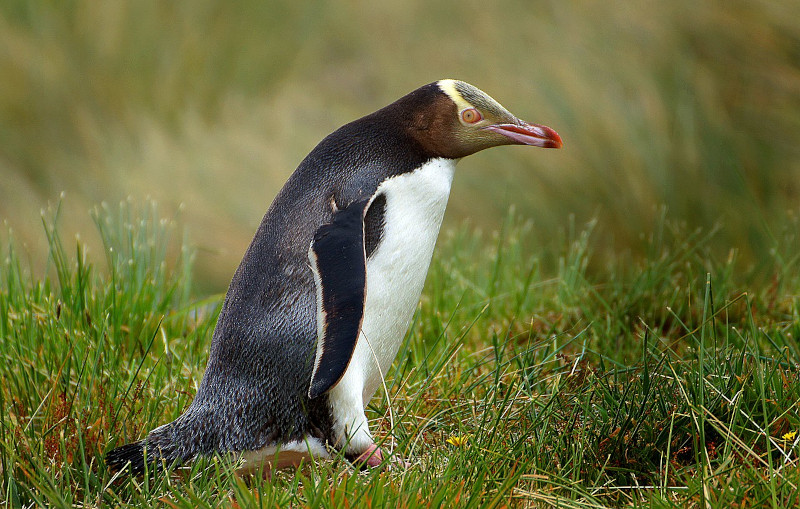
Yellow Eyed Penguin Facts
- The descriptive term of Yellow Eyed Penguin represents the most frequently used common name for this remarkable avian. The gorgeous flightless bird does have a few other general titles, though. Those include the terms tarakaka and hoiho.
- Most notably, but truly unfortunately, the fully stunning creation of Nature and evolution holds a very special status. That holds true due to the lamentable fact that the beautiful animal now ranks as one of the rarest varieties of penguin in the world.
- Regardless of its scant numbers, however, this amazing creature does have one thing working in its favor. The amazing bird actually has one of the longest natural lifespans of any related species. Individuals have the ability to live more than 20 years.
- Sadly, though, few individuals succeed in reaching this age, due to a wide variety of reasons. Unpleasantly, many of these reasons do not represent part of its natural environment. Yet these remain the same as those many species now face.
- More specifically, the animal principally faces two threats in particular. The primary threats that the magnificent creature faces include habitat degradation, for one. But the marvel also suffers from the introduction of non-native predators.
- Lamentably, due to all these factors, it now has a very small estimated remaining population. This consists of fewer than 4,000 individuals. Quite understandably, because of this sad state of affairs, the IUCN now lists it as Endangered on its Red List.
Related Articles
African Penguin
Yellow Eyed Penguin Physical Description
The magnificent Yellow Eyed Penguin certainly captures the attention and imagination of those who encounter it. It typically does so, however, largely because of its distinctive appearance. Rarely does size play a role in this, because in that respect it’s roughly average.
It does follow one pattern that’s quite common among its many relatives, though. That’s in the fact that it displays a certain amount of the physiological characteristic of sexual dimorphism. In its particular case, this trait manifests itself in terms of physical dimensions.
That’s due to the fact that males of the remarkable avian attain a greater average size than their female counterparts. As a general rule, though, the difference remains slight. Intriguingly, for undetermined reasons, males also tend to have a longer lifespan the females.
Overall, individuals of the aptly-named Yellow Eyed Penguin normally reach heights measuring between 24 – 31 in (62 – 79 cm). The weights tend to vary significantly, though, depending on the time of year. In general, this ranges between 6.6 – 18 lb (3 – 8 kg).
Its most distinguishing feature is obviously its eyes. These develop as bright yellow, and clearly serve as the inspiration for the name. Added to this uniqueness, however, is the black back, pale yellowish head, and a multi-colored beak with a randomly varying patterns.
- Kingdom: Animalia
- Phylum: Chordata
- Class: Aves
- Order: Sphenisciformes
- Family: Spheniscidae
- Genus: Megadyptes
- Species: M. antipodes
Yellow Eyed Penguin Distribution, Habitat, and Ecology
Unfortunately, the fabulous Yellow Eyed Penguin evolved as endemic to only a severely limited section of the world. It’s a region of the globe well known for other wonders. The precise location of that zone of habitation will probably surprise a few people, though.
Remarkably, this marvel of evolution only lives in selected portions of the the country of New Zealand. This area includes South Island, but only the southeastern portion. It also appears on parts of the islands of Auckland and Campbell, and coastal areas of Stewart.
It also evolved decidedly strong preferences regarding its choice of habitat. Most examples prefer to make their homes in regions comprised largely of either forest or scrub. It further displays a fondness for gentle slopes, the shore itself, or in small bays and headlands.
Again following the pattern shared by its relatives, the Yellow Eyed Penguin developed as a pure carnivore. Its diet primarily consists of small fish it catches near the seafloor. It does, however, occasionally augment this with various smaller cephalopods that it catches.
Breeding typically takes place in August, with eggs being laid in September. A brood almost always includes two eggs. These typically require 39 – 51 days to hatch. Both parents share the duties of caring for the eggs and foraging for food after they hatch.
Species Sharing Its Range
Check out our other articles on 7 Magnificent Wild Canines, Amethyst Deceiver, Pacific Sea Nettle, Gulfoss, Snoqualmie Falls, Rough-nosed Horned-Lizard, African Monarch
